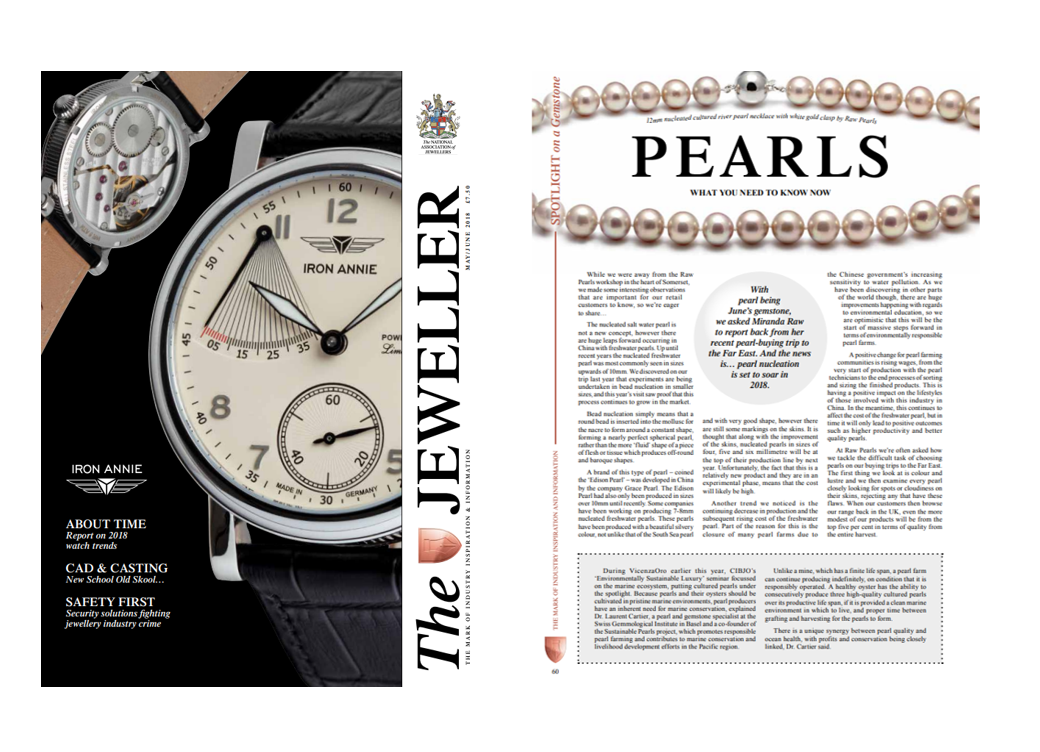Pearl nucleation to soar
The National Associations of Jewellers’ publication, The Jeweller Magazine were intrigued by our findings from our recent buying trip, so we told them more about it. Many thanks to them for publishing this in their May/June edition.
We have recently returned to the Raw Pearls workshop in the heart of Somerset from our first buying trip of the year to the far east. During our trip, we made some interesting observations that are important for our retail customers to know, so we’re eager to share…
The nucleated saltwater pearl is not a new concept, however, there are huge leaps forward occurring in China with freshwater pearls. Up until recent years, the nucleated freshwater pearl was most commonly seen in sizes upwards of 10mm. We discovered on our trip last year that experiments are being undertaken in bead nucleation in smaller sizes, and this year’s visit saw proof that saw proof that this process continues to grow in the market
Bead nucleation simply means that a round bead is inserted into the mollusc for the nacre to form around a constant shape forming a nearly perfect spherical pearl, rather than the more ‘fluid’ shape of a piece of flesh or tissue which produces off round and baroque shapes.
A brand of this type of pearl coined the ‘Edison Pearl’ was developed in China by the company Grace Pearl. The Edison Pearl had also only been produced in sizes from 10mm plus until recently. Some companies have been working on producing 7-8mm nucleated freshwater pearls. These pearls have been produced with a beautiful silvery colour, not unlike that of the South Sea pearl and with very good shape, however, there are still some marking on the skins. It is thought that along with the improvement of the skins, nucleated pearls in sizes of 4,5, and 6mm will be at the top of their production line by next year. Unfortunately, the fact that this is a relatively new product and they are in an experimental phase means that the cost will likely be high.
Another trend we noticed is the continuing decrease in production and the subsequent rising cost of the freshwater pearl. Part of the reason for this is the closure of many pearl farms due to the government’s increasing sensitivity to water pollution. As we have been discovering in other parts of the world though, there are huge improvements happening with regards to environmental education, so we are optimistic that this will be the start of massive steps forward in terms of environmentally responsible pearl farms.
A positive change for pearl farming communities is rising wages, from the very start of production with the pearl technicians to the end processes of sorting and sizing the finished products. This is having a positive impact on the lifestyles of those involved with this industry in China. In the meantime, this continues to affect the cost of the freshwater pearl, but in time it will only lead to positive outcomes such as higher productivity and better quality pearls.
At Raw Pearls we’re often asked how we tackle the difficult task of choosing pearls on our buying trips to the far east. The first thing we look at is colour and lustre and we then examine every pearl closely looking for spots or cloudiness on their skins, rejecting any that have these flaws. When our customers then browse our range back in the UK, even the more modest of our products will be from the top 5% in terms of quality from the entire harvest.
It’s so important to us to offer our customers beautiful quality pearls whilst providing the best possible value for money. Whilst in China we selected some stunning pearls to bring back and offer to our customers and we are really looking forward to doing so.


